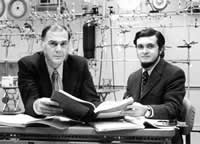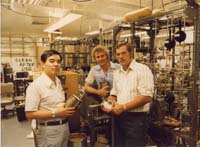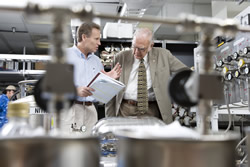Group History:
Chicago - Brookhaven - Kansas: Hot Atom Chemistry
Professor Rowland studied under Nobel Laureate Williard F. Libby at the University of Chicago. He studied radiochemistry, and finished his Ph.D. in 1952. His thesis concerned the chemical state of cyclotron-produced radioactive bromine atoms. The nuclear process not only creates a radioactive atom, but breaks it loose from all of its chemical bonds. These highly energetic atoms exist only in very, very low concentration, but can subsequently be traced by their eventual radioactive decay. Later in 1952 Professor Rowland moved (with his wife, Joan) to Princeton where he was an instructor in Chemistry. In each of the years from 1953-55, he spent the summer in the Chemistry Department of the Brookhaven National Laboratory. An early experiment there of putting a powdered mixture of the sugar glucose and lithium carbonate into the neutron flux of the Brookhaven nuclear reactor resulted in a one-step synthesis of radioactive tritium-labeled glucose, an article in Science, and a new sub-field of tritium "hot atom" chemistry. The United States Atomic Energy Commission (A.E.C.) also expressed considerable interest in this tracer chemistry, and offered support for continuation of the research.
In 1956, Professor Rowland moved to an Assistant Professorship at the University of Kansas, which had just completed a new chemistry building including special facilities for radiochemistry. Several excellent graduate students interested in radiochemistry joined my research group that summer, and were shortly joined by others and by a series of postdoctoral research associates, including many from Europe and Japan. This research group was very productive for the next eight years, chiefly investigating the chemical reactions of energetic tritium atoms and I moved through the ranks to a full Professorship.
The Founding of University of California, Irvine
The Irvine campus of the University of California was scheduled to open for students in September, 1965, and Professor Rowland moved his family there in August, 1964. He was Professor of Chemistry and the first Chairman of the Chemistry Department.
The A.E.C. support turned out to be truly long-term, surviving this transfer, and then the transformations of the A.E.C. into the Energy Research and Development Administration and then into the Department of Energy. That basic contract finally terminated in 1994, by which time NASA was furnishing the major support for our continuing research.
The ACS Breaktrough Award,
including
F.Sherwood Rowland: A Look Back
See the interview, video and pictures here
"Hot atom" chemistry continued to play a major role in our research efforts at the University of California Irvine. However, Professor Rowland deliberately followed a policy of trying to instill some freshness into his research efforts by every few years extending his work into some new, challenging aspect of chemistry - first, radioactive tracer photochemistry, using tritium and carbon-14; then chlorine and fluorine chemistry using the radioactive isotopes 38Cl and 18F.
When he decided in 1970 to retire from the Chemistry department chairmanship, he once again sought some new avenue of chemistry for our investigation. Because the state of the environment had become a significant topic for discussion both by the general public and within our family, he traveled to Salzburg, Austria, for an International Atomic Energy Agency meeting on the environmental applications of radioactivity. Afterward on the train to Vienna, he shared a compartment with an A.E.C. program officer also coming from the IAEA meeting. The program officer learned in the following conversation that Professor Rowland was personally interested in atmospheric science because of his early association and admiration for the 14C work of Bill Libby, and further that Professor Rowland's research had then been supported by the A.E.C. for the previous 14 years. Professor Rowland in turn learned that one of his A.E.C. responsibilities was the organization of a series of Chemistry-Meteorology Workshops, with the intention of encouraging more cross-fertilization between these two scientific fields. In due course, Professor Rowland was invited to the second of these workshops in January, 1972, in Fort Lauderdale, Florida, where he heard a presentation about recent measurements by the English scientist, Jim Lovelock, of the atmospheric concentrations of a trace species, the man-made chlorofluorocarbon CCl3F, on the cruise of the Shackleton to Antarctica. His shipboard observations showed its presence in both the northern and southern hemispheres, although in quite low concentration. One of the special advantages cited for this molecule was that it would be an excellent tracer for air mass movements because its chemical inertness would prevent its early removal from the atmosphere. As a chemical kineticist and photochemist, Professor Rowland knew that such a molecule could not remain inert in the atmosphere forever, if only because solar photochemistry at high altitudes would break it down. However, many other possible chemical fates could be imagined, and he wondered whether any of these might occur. In early 1973, Professor Rowland's regular yearly proposal was submitted to the A.E.C. and was duly approved and funded by them. In addition to the continuation of several radiochemistry experiments, he also included in the proposal a new direction - asking the question: what would eventually happen to the chlorofluorocarbon compounds in the atmosphere?

Professor Rowland and Mario Molina
The Chlorofluorocarbons
Later in 1973, Mario Molina, who had just completed his Ph. D. work as a laser chemist at the University of California Berkeley, joined the Rowland research group as a postdoctoral research associate. Offered his choice among several areas for our collaborative research, Mario chose the one furthest from his previous experience and from my own experience as well, and they began studying the atmospheric fate of the chlorofluorocarbon molecules. Within three months, Mario and Rowland realized that this was not just a scientific question, challenging and interesting to them, but a potentially grave environmental problem involving substantial depletion of the stratospheric ozone layer. A major part of both of their careers since has been spent on the continuing threads of this original problem.
Since 1973, the work of the research group has progressively involved more atmospheric chemistry and less radiochemistry. This research work has been conducted at the University of California Irvine by a strong, hard-working group of postdoctoral and graduate student research associates, together with some able technical specialists.
Towards the Rowland-Blake Group

Then graduate student Donald
Blake (center) in the Rowland
Laboratory, 1980, with Professor
Yoshi Makide, Univ. Tokyo, and then
UCI Graduate Student Stan Tyler.
In 1978 Professor Donald R. Blake joined the Research Group as a first year graduate student. By 1984 Professor Blake graduated with his Ph.D. in Chemistry. While a graduate student, Professor Blake studied global methane and ethane levels. He stayed on as a Postdoctoral Researcher under Professor Rowland. At this time levels of CFCs and hydrocarbons were beginning to be studied in a systematic fashion. By 1988 NASA funded many projects that enabled Professors Rowland and Blake to travel all over the world to obtain trace gas samples. This study of the composition of trace gasses is still being done today. Every quarter someone in the research group travels in different areas between 71 North and 71 South obtaining trace gas samples.
The research group has been heavily involved in a series of regional and global experiments, often since 1988 as participants in comprehensive aircraft-based atmospheric field research. Some of this research involves challenging and interesting scientific puzzles, and some can also be described as directed toward global environmental problems.

Professors D. R. Blake and F. S. Rowland discussing recent results in the laboratory, Rowland Hall, 2007
[Research] :
[Atmospheric Research]
[Breath Analysis Research]
[Laboratory Analytical Capabilities]
[Group History]